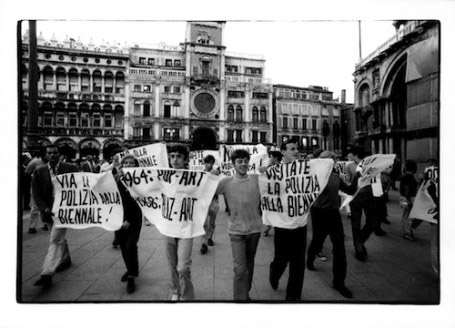
| HOME |
| NERVE |
| REVIEWS |
| ARCHIVE |
| EVENTS |
| LINKS |
| ABOUT US |
| CONTRIBUTORS |
| BACK ISSUES |
| CONTACT US |
Not All Documents Are Records: Photographing Exhibitions As An Art Form
 The
Open Eye Gallery, 19 Mann Island
The
Open Eye Gallery, 19 Mann Island
Til the 19th of October 2014
Free entry
Reviewed by jjSchaer
Not All Documents Are Records is a current photographic exhibition in The Open Eye Gallery, located at the base of the monolithic Mann Island Towers, and is part of the on-going Liverpool Biennial. It explores the notions behind capturing exhibitions photographically and its subsequent effects on the works and those viewing them. It is composed of two historic series of photographs and one commissioned for the gallery. The show has a focus on biennials, present and past, but offers a more dark and investigative insight into such festivities.
It opens with new work for Cristina De Middel which features photos of artworks from a previous Liverpool biennial which have now been censored with purple cardboard. This includes huge purple blocks looming before St Georges Hall, purpled spider web hanging between building and an entire gallery lined with purple blocks. I was told by the gallery attendant that De Middel had photographed a number of the exhibits for a previous piece. However, she soon found that most artists wanted exorbitant fees for her to show the images and working with non-profits like the Open Eye meant this was unobtainable. There is a certain amount of humour behind the piece which is amplified by a large mock newspaper article in the centre of the gallery telling of pigeons ethically burning dead humans in the street as art.
There is also a collection from Ugo Mulas entitled ‘Twenty Years of Biennial’ which features a number of pictures largely from the 1968 biennial in Venice. The Venetian biennial was the first in the world and is seen as setting the format for all future biennials. Some of the pictures show celebs mingling inside galleries, clinking champagne flutes and laughing. These are juxtaposed against bearded hippies massing protests in the street and rioting against swathes of armed police. Others depicting the aftermath, galleries covered in glass and artworks smashed into oblivion. The biennial was seen to many at the time as becoming more right wing and representing art for the establishment. This led to the unrest amongst the more lefty art community of the time. Mocked placards from the event lay strewn about the gallery, containing phrases such as “1964: Pop Art / 1968: Police Art” and “The Bienniale is fascist”, whilst news footage plays on a retro television set that depicts the madness that erupted on the day.
The final exhibition, tucked away on the top floor, was a clever and humorous set of photographs by Hans Haacke. It depicts a number of people in art galleries and their various reactions to the masterpieces before them. A young child in stereotypical 50s garb can be seen engrossed in a Mickey Mouse comic completely oblivious to the Kandinsky behind him. Old people can be seen left and right looking completely disinterested. There is one of a woman playing with a child on a bench whilst a huge Pollock looms over them and one of a nun looking wholly out of place in a modern art gallery. There some behind the scenes shots of workers smoking in front of packed up Rothko’s and a famous Moore sculpture not looking wholly out of place in a courtyard filled with construction rubble. With all the photos the art is no longer the centrepiece but a nice bit of decorative backing to the life that goes on before it.